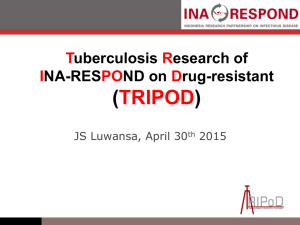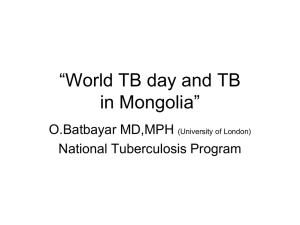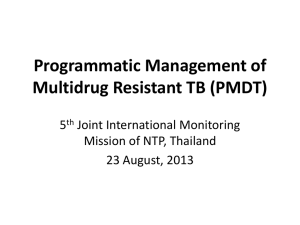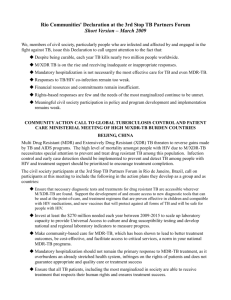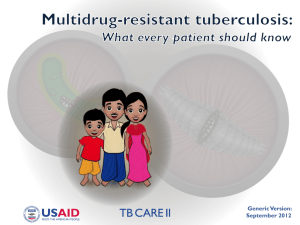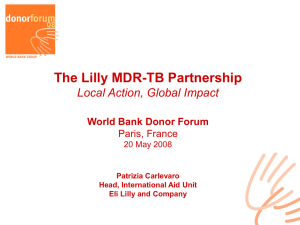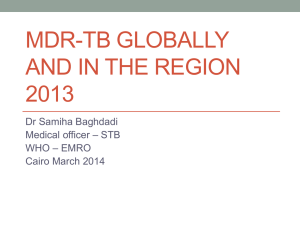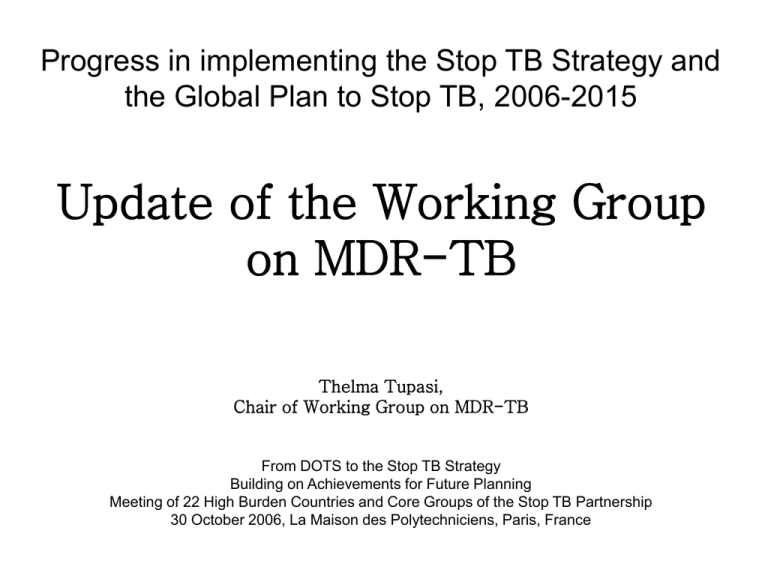
Progress in implementing the Stop TB Strategy and
the Global Plan to Stop TB, 2006-2015
Update of the Working Group
on MDR-TB
Thelma Tupasi,
Chair of Working Group on MDR-TB
From DOTS to the Stop TB Strategy
Building on Achievements for Future Planning
Meeting of 22 High Burden Countries and Core Groups of the Stop TB Partnership
30 October 2006, La Maison des Polytechniciens, Paris, France
Outline
• Goal of the Global Plan 2006-2015
– Launched Jan, 2006
– To enroll on treatment 800,000 MDR-TB patients
from 2006 to 2015
• MDR-TB in the new Stop TB strategy
– Launched March 2006)
– To mainstream management of MDR-TB in TB
control programmes ensuring access to rational
treatment for ALL cases diagnosed with MDR-TB
Outcome of the Fifth Working Group meeting,
May 12, 2006, Atlanta, US
Four major challenges to scale up MDR-TB
management were identified
-Political commitment at country level and
resource mobilization
-Human resources
-Capacity to diagnose all cases of MDR-TB
-Drug management of second-line TB drugs
Challenge 1:
Increased and sustained political commitment
to scale-up sound TB control programmes
400
140,000
350
120,000
300
100,000
250
80,000
200
60,000
150
40,000
100
20,000
50
0
0
2000
2001
2002
2003
2004
2005
2006
2007
2008
GLC-reviewed applications
Applications: Scenario 1 - Steady growth
Applications: Scenario 2 - Rapid growth
GLC-reviewed patients
Patients: Scenario 1 - Steady growth
Patients: Scenario 2 - Rapid growth
Number of patients
Number of applications
Two growth projections for scaling up MDR-TB management
Challenge 2: Human resources
•Limited number of consultants trained and
experienced in assisting on MDR-TB
managment
•Quantity of properly trained human resources
needed for scaling up MDR-TB management
at country level is unknown
Challenge 3: Laboratory capacity
450,000
400,000
350,000
300,000
with estimated 45%
case detection rate
250,000
200,000
150,000
100,000
with estimated 5%
DST coverage
50,000
0
Cases estimated
Source: WHO/STB/THD
detected with MDRTB
Challenge 4: Drug management
Limited quantity of quality-assured
manufacturers and products
High cost of second-line TB drugs
Market of second-line TB drugs
needs to become more robust
Outcome of the Fifth Working Group meeting,
May 12, 2006, Atlanta, US
Revitalize the Working Group in order to face these challenges:
-To create several subgroups within the WG:
- Resource mobilization and advocacy
- Research
- Drug management
- Focal person on laboratory needs for MDR-TB
management
- Infection control (created in October 2006, after the
meeting of the WHO Global Task Force on XDR-TB).
-To produce an operational plan to scale up MDR-TB according
to the Global Plan and the emerging challenge of XDR-TB
(underway)
Progress in addressing the challenges for
operationalizing the Strategic Plan of the WG
• Sustained commitment to scale up
– Business plan for the GLC developed by WHO
Working Group Secretariat thanks to generous
support of USAID
– Board of the GFATM agreed to fund GLC
operations under a cost-sharing scheme. First
disbursement expected in 2007.
– UNITAID gave green light for funding secondline TB drugs for MDR-TB management,
operationally through GFATM and directly
through GLC
Major progress in the political commitment to
manage MDR-TB in several HBCs
• China: GFATM approved pilot project for 4,000 patients
• India:
• WHO Guidelines for programmatic management of drug
resistant TB adapted
• First application for MDR-TB management in two states
reviewed by GLC 1st November, 2006
• Plan of at least one MDR-TB project in 20 states by 2010
• Russia:
• Project to treat 7,500 MDR-TB patients in 12 oblasts
approved by GFATM.
• Ten applications under review/ to be approved by the GLC.
• Major progress in laboratory capacity to diagnose drug
susceptibility testing.
• Eight high burden TB countries: GLC-supported
Programmatic MDR-TB management
40
Scaling up of Programmatic
MDR-TB treatment through the GLC
Projects approved
Oct 2006 – 40 projects
35
Almost
23'000
patients
approved for
enrolment
30
25
20
15
10
5
0
2000
2001
2002
2003
2004
2005
2006
Countries with GLC approved projects
Total: 40 countries – 22 working with GFATM
GFATM support
•
•
•
•
•
•
•
•
•
•
•
•
•
•
•
•
•
•
•
•
•
•
Azerbaijan
Bangladesh*
Bolivia
DR Congo*
Dominican Republic
Ecuador
Egypt
Georgia
Honduras
Kenya*
Kyrgyzstan
Mongolia
Moldova
Nicaragua
Peru
Philippines*
Paraguay
Romania
Russia*
El Salvador
Timor-Leste
Uzbekistan
Domestic or other donor support
GLC applications under review
•
Armenia
•
6 regions in Russian
•
Belize
Federation (GFATM)
•
Burkina Faso
•
China (GFATM)
•
Costa Rica
•
Kazakhstan (non GFATM)
•
Estonia
•
Guinea
•
Uganda (non GFATM)
•
Haiti
•
India (both GFATM, other
•
India*
donors and domestic
•
Jordan
resources)
•
Cambodia*
•
Lebanon
•
Lithuania
•
Latvia
= More than 23,000 MDR-TB patients
•
Mexico
•
Nepal
•
Rwanda
•
Syria
•
Tunisia
Status of GLC collaboration in high TB
burden countries as of October 2006.
GLC approved:
National TB Programs:
• Bangladesh
• DR Congo
• Kenya
• China
• Russian Federation
• The Philippines
Non-NTP
• India
• Cambodia
GLC under consideration
National TB Program:
• India
Non-NTP
• Uganda
GLC application
underway
• Myanmar
Status of PMTM in high TB burden
countries as of October 2006.
NTP:
• Brazil,
• DR of the
Congo,*
• Mozambique,
• Philippines,*
• South Africa,
• Russian Fed*
• Thailand
GLC approved
NTP:
• India
• China
• Bangladesh
• Kenya
Operational Study
• Cambodia
Not NTP
• Uganda
• India in New Delhi
Status of PMTM funding in high TB
burden countries as of October 2006.
The three major
obstacles
• weak laboratories,
• lack of funding
• lack of qualified staff
GFATM funded DRS
• Cambodia,
• Nigeria
• Zimbabwe
GFATM funded MDR-TB
management
• Kenya
• Philippines
GFATM has approved
funding for both DRS
and MDR-TB control in
7 HBCs
• Bangladesh,
• China,
• DR of Congo,
• India,
• Indonesia,
• Mozambique
• Russia..
Progress in addressing the challenges for implementing the
Global Plan and new Stop TB strategy
• Human resources
– Second course of MDR-TB consultants, Latvia, Nov,
2006
– First MDR-TB training workshop in Africa, Dar-es
Salaam, Oct, 2006.
– Generic training modules for case finding and
management under development in the Philippines
– Online training module for MDR-TB management
produced by World Medical Association, based on
WHO Guidelines with Eli Lilly support
– SEARO MDR course Feb 2007
– country training courses: Philippines, Korea
– the PIH course
Progress in addressing the challenges for implementing the
Global Plan and new Stop TB strategy
• Laboratory capacity
– To be reported by the DOTS expansion
Working Group
– expansion of the SRL
– planned training courses for FLD/SLD
DST in conjunction with the SCLS
– Drug Resistance Survey
Coverage of
Anti-Tuberculosis Drug Resistance Surveillance
no data
estimates
sub-national surveys
countrywide surveys
The boundaries and names shown and the designations used on this map do not imply the expression of any opinion whatsoever on the part of the World Health Organization
concerning the legal status of any country, territory, city or area or of its authorities, or concerning the delimitation of its frontiers or boundaries. Dotted lines on maps represent
approximate border lines for which there may not yet be full agreement. WHO 2006. All rights reserved
Drug Resistance Survey in HBCs
• 11 had carried out nationwide DRS by 2006
– Philippines
– Ethiopia
– Tanzania
•
Six high burden countries are expanding regional
coverage of drug resistance surveys
– India, China and Russia have all made major progress
– China is planning a nationwide survey in 2007
• Indonesia has its first drug resistance survey underway
• Afghanistan, Nigeria, Bangladesh and Pakistan have no
DRS and except Afghanistan plan to carry out surveys.
Cumulative DRS population coverage by
WHO region - expected 2007
1.0
Population coverage
0.9
0.8
0.7
0.6
0.5
0.4
0.3
0.2
0.1
0.0
AFR
AMR
EMR
EUR
WHO region
SEAR
WPR
Progress in addressing the challenges for implementing the
Global Plan and new Stop TB strategy
• Drug supply
– UNITAID agreed to fund the WHO prequalification
programme, including all TB drugs
– Three major meetings, funded by BMGF, held with
manufacturers in Russia and China to promote
WHO prequalification,
– Update on WHO Prequalification project
• 7 seven manufacturers applied
• 13 dossiers submitted
• 1 manufacturer WHO GMP approved
• no product yet WHO approved
Subgroup on Research
• Officially established in July 06
• Several institutions involved:
– KNCV (Chair), CDC, PIH, MRC-South Africa,
University of Alabama-US, TRC-India
– Secretariat in WHO/STOP TB
• 4 meetings by teleconference and 1 in person
(this week)
• First task: to develop a new prioritized research
agenda on drug resistant TB
– first draft ready and circulated for comments
Acknowledge
• The work of the Working Group and the
WHO Secretariat has been possible
thanks to the generous funding of:
– BMGF
– Eli Lilly Inc
– DFID
– USAID

